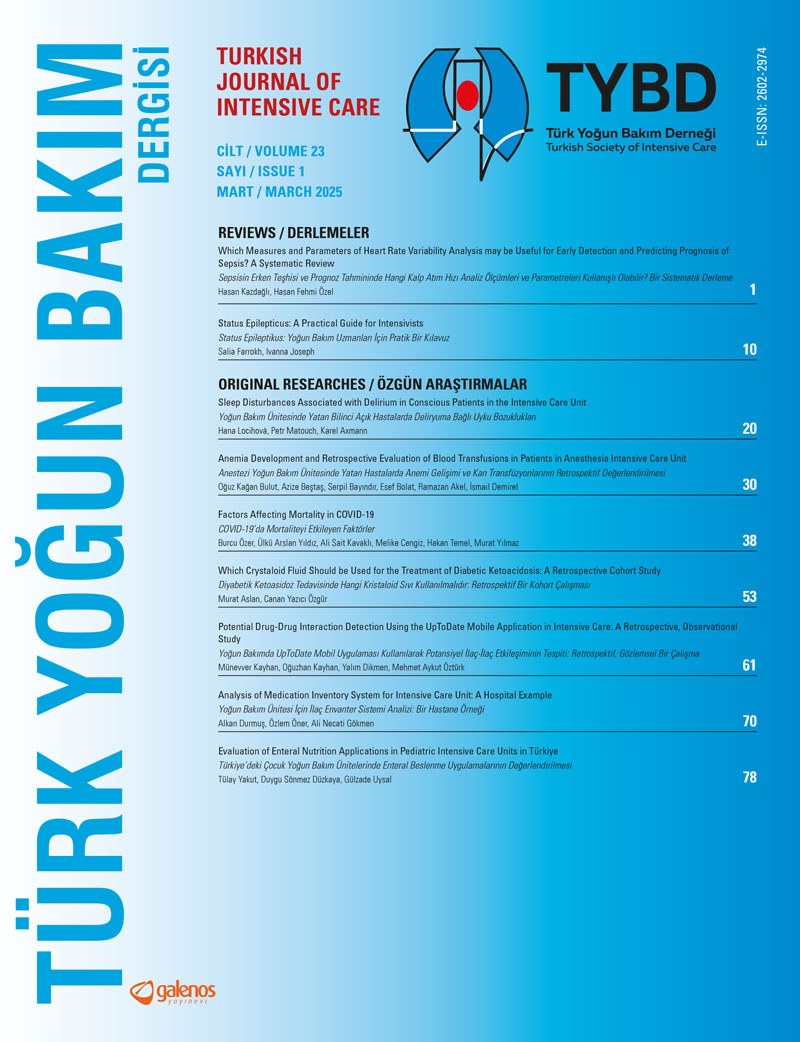Öz
Bu derleme, erişkinlerde status epileptikusun patofizyolojisini, insidansı ve temel klinik hususları ile birlikte araştırmaktadır. Acil tedavileri vurgulayan kapsamlı bir tedavi yaklaşımı sunulmuştur. Bu derlemede ayrıca klobazam ve brivaracetam gibi yeni ajanların rolü incelenmiş, kritik hastalarda sık kullanılan nöbet önleyici ilaçların doz stratejileri ve potansiyel ilaç-ilaç etkileşimleri de araştırılmıştır. Refrakter ve süper refrakter status epileptikus için tedavi stratejileri de tartışılmıştır. Son olarak, nöbetin kesilmesini takiben uygulanan sedatifler için dozlama ve titrasyon kılavuzlarının yanı sıra yapılandırılmış bir yönetim yaklaşımı için pratik bir algoritma sunulmuştur.
Anahtar Kelimeler: Status epileptikus, farmakoterapi, nöbet önleyici ilaçlar
Referanslar
- Trinka E, Cock H, Hesdorffer D, Rossetti AO, Scheffer IE, Shinnar S, et al. A definition and classification of status epilepticus--Report of the ILAE Task Force on Classification of Status Epilepticus. Epilepsia. 2015;56:1515-23.
- Lv RJ, Wang Q, Cui T, Zhu F, Shao XQ. Status epilepticus-related etiology, incidence and mortality: a meta-analysis. Epilepsy Res. 2017;136:12-7.
- Lu M, Faure M, Bergamasco A, Spalding W, Benitez A, Moride Y, Fournier M. Epidemiology of status epilepticus in the United States: a systematic review. Epilepsy Behav. 2020;112:107459.
- Trinka E, Höfler J, Zerbs A. Causes of status epilepticus. Epilepsia. 2012;53:127-38.
- Singh RK, Stephens S, Berl MM, Chang T, Brown K, Vezina LG, et al. Prospective study of new-onset seizures presenting as status epilepticus in childhood. Neurology. 2010;74:636-42.
- Mayer SA, Claassen J, Lokin J, Mendelsohn F, Dennis LJ, Fitzsimmons BF. Refractory status epilepticus: frequency, risk factors, and impact on outcome. Arch Neurol. 2002;59:205-10.
- Walker MC. Pathophysiology of status epilepticus. Neurosci Lett. 2018;667:84-91.
- Meldrum BS, Horton RW. Physiology of status epilepticus in primates. Arch Neurol. 1973;28:1-9.
- Treiman DM, Meyers PD, Walton NY, Collins JF, Colling C, Rowan AJ, et al. A comparison of four treatments for generalized convulsive status epilepticus. N Engl J Med. 1998;339:792-8.
- Silbergleit R, Lowenstein D, Durkalski V, Conwit R, Neurological Emergency Treatment Trials (NETT) Investigators. RAMPART (Rapid Anticonvulsant Medication Prior to Arrival Trial): a double-blind randomized clinical trial of the efficacy of intramuscular midazolam versus intravenous lorazepam in the prehospital treatment of status epilepticus by paramedics. Epilepsia. 2011;52:45-7.
- Misra UK, Kalita J, Patel R. Sodium valproate vs phenytoin in status epilepticus: a pilot study. Neurology. 2006;67:340-2.
- Agarwal P, Kumar N, Chandra R, Gupta G, Antony AR, Garg N. Randomized study of intravenous valproate and phenytoin in status epilepticus. Seizure. 2007;16:527-32.
- Kapur J, Elm J, Chamberlain JM, Barsan W, Cloyd J, Lowenstein D, et al. Randomized trial of three anticonvulsant medications for status epilepticus. N Engl J Med. 2019;381:2103-13.
- Farrokh S, Bon J, Erdman M, Tesoro E. Use of newer anticonvulsants for the treatment of status epilepticus. Pharmacotherapy. 2019;39:297-316.
- Claassen J, Hirsch LJ, Emerson RG, Mayer SA. Treatment of refractory status epilepticus with pentobarbital, propofol, or midazolam: a systematic review. Epilepsia. 2002;43:146-53.
- Farrokh S, Tahsili-Fahadan P, Ritzl EK, Lewin JJ, Mirski MA. Antiepileptic drugs in critically ill patients. Critical Care. 2018;22:153.
- Hocker SE, Britton JW, Mandrekar JN, Wijdicks EF, Rabinstein AA. Predictors of outcome in refractory status epilepticus. JAMA Neurol. 2013;70:72-7.
- Syed MJ, Zutshi D, Muzammil SM, Mohamed W. Ketamine to prevent endotracheal intubation in adults with refractory non-convulsive status epilepticus: a case series. Neurocrit Care. 2024;40:976-83.
- Kimmons LA, Alzayadneh M, Metter EJ, Alsherbini K. Safety and efficacy of ketamine without intubation in the management of refractory seizures: a case series. Neurocrit Care. 2024;40:689-97.
- Legriel S, Oddo M, Brophy GM. What’s new in refractory status epilepticus? Intensive Care Med. 2017;43:543-6.
Telif hakkı ve lisans
Telif hakkı © 2025 Yazar(lar). Açık erişimli bu makale, orijinal çalışmaya uygun şekilde atıfta bulunulması koşuluyla, herhangi bir ortamda veya formatta sınırsız kullanım, dağıtım ve çoğaltmaya izin veren Creative Commons Attribution License (CC BY) altında dağıtılmıştır.






















